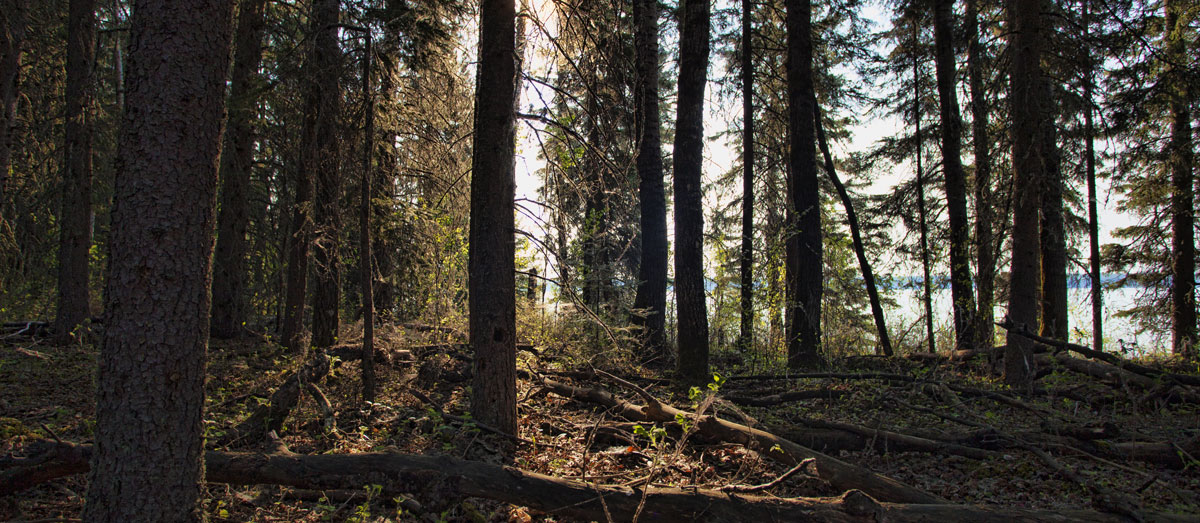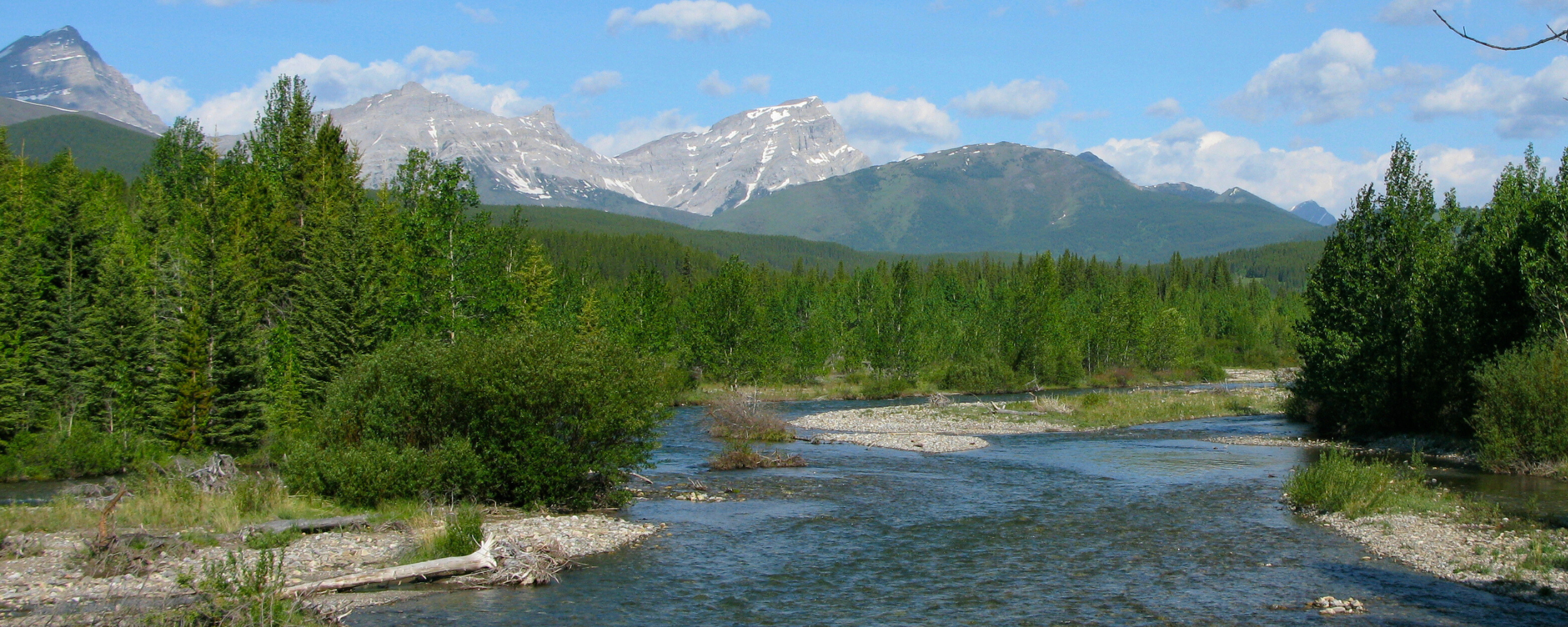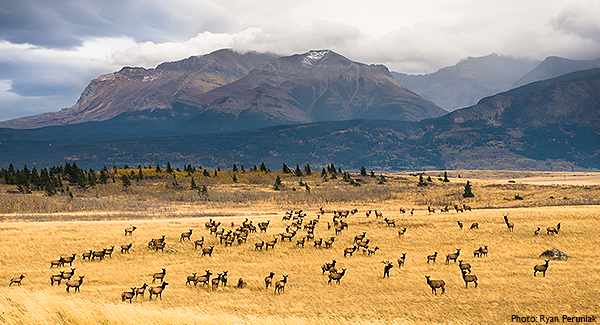
By Kirsten Olson
Office and Fund Program Administrator,
CPAWS Southern Alberta
It may seem that once public lands have been given the protected designation of “Park” that their permanent existence is assured, but this has not always been the case. A brief history of some of our best and least known national parks demonstrates why we need to ensure that our protected areas remain protected and are managed by ecological principles.
The Dominion Lands Act of 1872 was a federal law that granted lands in western Canada to colonizers, companies, towns, and religious groups. The Act also set aside land for First Nations reserves and lands that would eventually become national parks. The Canadian Pacific Railway was granted rights-of-way that made traditional indigenous territories, in what is now Alberta, accessible to non-indigenous settlers. In November, 1885, a few days after the last spike was ceremonially pounded into the ground at Craigellachie, B.C., railway workers found natural hot springs near Banff and sought to capitalize on this potential tourist attraction. However, before they could lay claim to the area, the Government of Canada set aside about 26 km2 around the hot springs for a future park. This was followed by the Rocky Mountain Park Act of 1887 which included Lake Louise Forest Park, Jasper Forest Park, Rocky Mountain Forest Reserve and Rocky Mountain Park (Banff). The National Park at Banff was expanded to 673 km2 and established the park system in Canada.(i)
BANFF GIVE AND TAKE
The Dominion Reserves and Parks Act replaced the Rocky Mountain Parks Act in 1911, and the initial reserved lands—from north of Jasper to as far south as Lake Louise—were reduced by more than half.(ii) Pressure to exclude lands from national parks that were of commercial value achieved success in the provisions of the Natural Resources Transfer Agreement of 1929. The resulting National Parks Act, 1930, removed areas to the east and south of Banff, including much of today’s Kananaskis Country and Peter Lougheed Provincial Park.(iii)
THE ABANDONED CASTLE

There were a variety of reserves that could be established under The Dominion Land Act. Banff, as described in the dedication clause of the 1887 Rocky Mountain Park Act, was recognized as “a public park and pleasure ground for the benefit, advantage and enjoyment of the people of Canada.”(iv) In contrast, Waterton Lakes Park Reserve, established in 1895 as a Forest Reserve, had a lower level of protection. Eventually, lands reserved for parks and those reserved for forests were joined under the Dominion Forest and Parks Act of 1911. Unfortunately, this resulted in Waterton being reduced in size. The newly established Dominion Parks Branch, created by the 1911 Act and led by James B. Harkin, pressured the government to review the reduced boundaries. As a result, Waterton was expanded to its largest historic size of 1095.5 km2 in 1914.(v) This included the Castle region, which is northwest of the park that we know today. Unfortunately, this arrangement did not last, and in 1921 the northwest portion was removed from Waterton Lakes Park and reincorporated into the Rocky Mountain Forest Reserve.(vi)
WHERE THE BUFFALO ROAMED
Most early park policies were based on economic motives, starting from the commercialisation of the Banff hot springs to the development of mining and timber resources.(vii) In contrast, the site of Buffalo National Park, a prairie park near the town of Wainwright, had little commercial potential and was created in 1908 to protect and grow the dwindling population of bison. Ottawa purchased about 700 bison, mostly from Montana rancher Michel Pablo, and transported them by train to the new National Park beginning in 1909. Small populations of elk and moose were also moved into the park.
The herd of bison grew to such a large size that the animals succumbed to disease, particularly tuberculosis, and starvation due to overgrazing. Animals were culled annually starting in 1921 and the sanctioned slaughter caused a public outcry. The parks branch marketed bison meat to the public and used it for food in relief camps and for Inuit relief during the Great Depression.(viii) About 6000 plains bison were moved to Wood Buffalo National Park in the 1920s with little regard for interbreeding or disease transfer. The move also did little to control the growing numbers. The last of the herd was slaughtered during the winter of 1940-41, and the park was delisted and turned over to the military in 1947.
Other Alberta parks that were delisted in 1947 include Wawaskesy National Park, which was just north of Medicine Hat; Menissawok National Park in the Cypress Hills; and Nemiskam National Park just east of Foremost. All three had become national parks in 1922 to help save pronghorn antelope from near extinction. The project was a success, and antelope from these parks were the source of herds that spread throughout the grasslands of Alberta and Saskatchewan. By 1946, there were nearly 30,000 free-ranging antelope, and the powers that be no longer saw any need for these parks.(ix)
We now have a better understanding of conservation science and effective park management. Organizations like CPAWS effectively work with government, industry, and other stakeholders to ensure that conservation remains the core value of park management. We have spent the past 50 years working to protect areas like Kananaskis Country and the Castle. Parks and protected areas are an important part of Alberta’s landscape that we would like to see properly managed and protected without the threat of parks being delisted in the future.
iPeter Murphy, “Following the Base of the Foothills,” Culturing Wilderness in Jasper National Park: Studies in Two Centuries of Human History in the Upper Athabasca River Watershed (Edmonton: University of Alberta Press, 2007) 77.
iiW.F. Lothian, A History of Canada’s National Parks, vol. 1 (Ottawa: Indian and Northern Affairs, Parks Canada, 1976), 18 Mar. 2018 http://parkscanadahistory.com/publications/history/lothian/eng/vol1/chap1.htm.
iiiBill Yeo, “Gateway to the Rocky Mountains,” Remembering Chinook Country: Told and Untold Stories of Our Past (Calgary: The Chinook Country Historical Society, 2005) 221.
ivLothian.
vGraham A. MacDonald, Where the Mountains Meet the Prairies: A History of Waterton Country (Calgary: University of Calgary Press, 2000) 50.
viLothian.
viiJennifer Brower, Lost Tracks: National Buffalo Park, 1909-1939 (Edmonton: AU Press, 2008) 31-34.
viiiIbid, 73, 75.
ix“A National Park is Abolished!” This Week in History, week of 25 June 2001, Parks Canada Archives, 18 Mar. 2018 https://www.pc.gc.ca/apps/cseh-twih/archives2_E.asp?id=182
More Blog Posts

Speak Up, Write Out: The Power of a Local Op-Ed

Fine Issued to Forestry Operator for Erosion Control Failures


